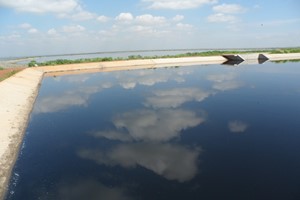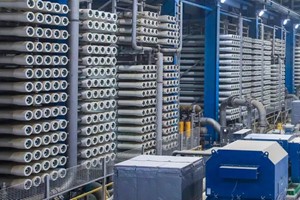Monitoring organic loads, particularly Total Organic Carbon (TOC), has become increasingly vital in wastewater treatment, especially in industries with highly variable waste streams like food and beverage (F&B). The need for rapid, reliable data has spurred a transition from traditional methods to advanced TOC monitoring. Jens Neubauer and Christian Kuijlaars from Veolia Water Technologies & Solutions provide insights on how TOC analysis is transforming wastewater treatment and improving operational efficiency.
In most wastewater, organic contaminants dominate, particularly in sectors like F&B. The primary objective of treatment is to break down these organic substances and remove them from the water. However, as treatment processes accelerate due to advancements in technology, real-time monitoring is essential to address fluctuations in wastewater composition. Any significant changes in organic loads can drastically affect treatment outcomes, making real-time monitoring tools a necessity.
Traditional methods, such as chemical oxygen demand (COD) and biochemical oxygen demand (BOD) tests, have been widely used to measure organic waste in water. However, these methods are time-consuming, often taking hours to days, and rely on toxic reagents, making them unsuitable for faster, more efficient treatment processes. TOC analysis, on the other hand, provides results within minutes and does not require harmful chemicals, making it better suited for modern wastewater treatment systems. Moreover, TOC analysis is now the preferred method in the latest European Union (EU) standards, such as the Commission Implementing Decision (EU) 2016/902 under Directive 2010/75/EU, for monitoring organic loads and ensuring discharge control.
TOC monitoring offers critical insights into carbon loading at different stages of the treatment process. By measuring TOC before biological treatment, operators can detect disturbances in carbon loading and divert excess to buffer tanks when necessary. This prevents the plant from becoming overwhelmed and ensures stable, efficient operations. TOC measurements before and after settling also help optimize coagulant dosing, regulating carbon addition to avoid overfeeding or starving the bacteria during different treatment phases. Furthermore, real-time TOC monitoring at discharge points provides data on carbon levels being released into the environment, ensuring compliance with environmental regulations.
In tertiary treatment, where wastewater is often reused, TOC monitoring helps optimize chemical dosing, membrane pre-treatment, and disinfection methods like UV or ozone treatment. These optimizations not only improve efficiency but also reduce operational costs.
Anaerobic reactors are often used to treat highly contaminated wastewater, such as in the F&B industry. However, these systems face unique challenges due to the highly concentrated nature of the waste streams. When organic loads fluctuate—common in industrial wastewater—system efficiency drops, increasing the need for chemical consumption and post-treatment processes. Fluctuations can also affect biogas production, a key byproduct of anaerobic treatment that contributes to energy recovery.
Monitoring TOC in anaerobic systems presents challenges due to the high levels of contamination, particles, fats, oils, and grease (FOG) in the wastewater. Traditional analyzers often struggle with these contaminants, leading to blockages and inaccurate measurements. To overcome these issues, advanced systems like Veolia's Sievers TOC-R3 have been developed. This device uses high-temperature combustion without catalysts, features a narrow 2 mm sample path, and offers self-cleaning options, ensuring accurate and reliable measurements even in highly contaminated waste streams. Additionally, the device’s pH regulation helps counteract fluctuations caused by cleaning cycles or production changes.
Fluctuating organic loads are a significant challenge in industries that rely on batch processing and have variable waste streams. When the organic load changes suddenly, anaerobic reactors must constantly adjust, leading to increased chemical usage and more demanding post-treatment processes. TOC monitoring helps manage these fluctuations by providing real-time data, allowing operators to stabilize the feed stream and improve overall system efficiency. Systems with stable feed streams produce cleaner effluents, reducing the burden on aerobic post-treatment systems and lowering operational costs. Additionally, stable systems lead to increased biogas production, maximizing energy recovery.
Integrating TOC monitoring into anaerobic reactor operations requires careful planning. TOC data allows operators to divert high-concentration streams to buffer tanks, adjust feed pumps, and maintain steady organic loads to the reactor, ensuring the system operates efficiently. The insights provided by TOC monitoring help fine-tune the process, reducing the impact of fluctuations and minimizing the need for downstream post-treatment.
The importance of wastewater treatment is expected to grow as water becomes an increasingly scarce resource globally. TOC monitoring, which already offers the best method for providing real-time data on organic contamination, will become even more critical in meeting tightening regulatory requirements. In the future, more wastewater treatment plants will adopt TOC analyzers, particularly in remote, unmanned facilities where remote monitoring and maintenance will be essential.
Veolia’s Sievers TOC-R3 is designed with these future needs in mind. It includes state-of-the-art features like self-monitoring, remote maintenance capabilities, and low operating costs, positioning it as a forward-looking solution for the evolving demands of wastewater treatment.
TOC monitoring has become essential in modern wastewater treatment, especially in industries with highly variable waste streams like F&B. As TOC technology continues to advance, treatment plants are becoming more efficient, reducing chemical consumption and maximizing biogas production. With growing water scarcity and increasingly stringent regulations, TOC monitoring will remain a cornerstone of effective and sustainable wastewater management.













